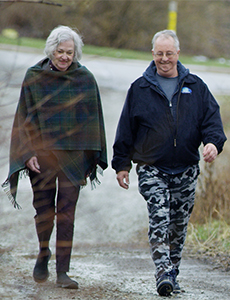Nurse Case Manager Chronicles
Getting Injured Workers Off Opioids: What Role Does Your Nurse Case Manager Play?

Paradigm’s Linda Kenavey played a key role in helping Tim Stout get his life back, opioid-free.
Tim Stout, a worker for a glass factory, was laying lines one day when he was struck on his left side by a large mold and crushed between the machine and a wall.
He had multiple rib fractures. His left lung was crushed. He suffered third-degree burns to his left arm and a pulmonary collapse.
But Stout was determined to heal and began the long process of recovery with a positive attitude. Unfortunately, his pain was intense, and opiates were introduced into the mix.
Opioids in Workers’ Comp
Prescription opioid misuse costs the United States $78.5 billion each year for health care costs, lost productivity, addiction treatment and criminal justice involvement. Around 21 to 29 percent of patients prescribed opioids end up misusing them, and of these, 4 to 6 percent transition to heroin abuse.
In workers’ compensation, opioids make up a third of all prescribed pain relief drugs.
“When people are injured, they want pain relief. Everyone wants to be pain free. We’ve programmed an entire generation to believe they shouldn’t have pain,” said Linda Kenavey, network manager, Paradigm Outcomes.
When asked how often she encounters opioids in comp claims, Kenavey said, “Probably every day in every case.”
VIDEO: As awareness of opioid dangers has increased, patients like Tim Stout (right) are open to learning how to manage their pain without addictive drugs.
Thankfully, however, “now that the opioid epidemic came center stage, there is more of an awareness. Workers’ compensation carriers are recognizing the costs that come with treating workers for opiate addiction.”
On top of that, injured workers are conscious of the negative effects opioids can have on their healing process and their transition back to work.
Until recently, Kenavey said, it was rare to hear a patient say, “I don’t want to take that.” Now the story is different, because there is so much information out there on the dangers of opioids.
This was much like Stout’s case. He knew opioids were dangerous, and he wanted to get off them before a toxic and addictive pattern was born.
Workers Advocating for Their Well-Being
“As far as I know, since I wasn’t on his case until two years in, he had always been on opiates. The physicians did decrease frequency and dose, but he was always on them,” said Kenavey, who became this worker’s nurse case manager in 2016.
“He was nonfunctional. When I first met him; functionality was very limited. He couldn’t participate in his daily life. He described his lifestyle as having been completely changed since his injury, making even the simplest activity of daily living a challenge.”
“When people are injured, they want pain relief. Everyone wants to be pain free. We’ve programmed an entire generation to believe they shouldn’t have pain.” — Linda Kenavey, network manager, Paradigm Outcomes
Most important to Stout was walking his dog. But while the dog was a great motivator to get this injured worker moving, Kenavey noted, Stout was having trouble keeping up with the dog’s pace.
Kenavey managed the case onsite for Paradigm, which, she said, had a team of specialists who coordinated with Stout’s treating physician on a program focused primarily on function and restoration.
Extensive physical therapy proved a moot point; it helped, but not nearly enough to get Stout back to his routine. Kenavey even had him in aqua therapy and a cognitive behavioral program for three months.
“We saw improvement, but he wanted more.”
Finally, Stout was sent to The Rosomoff Comprehensive Rehabilitation Center in Miami, Florida. Kenavey spoke of this center’s excellence, stating that Stout had “terrific gains” after his one-month stay.
It was a big turning point for him.
“He was invigorated when he was discharged from the program and able to walk his dog twice daily, sometimes two miles at a time without distress,” said Kenavey.
“Upon returning to his home, he was completely off of all opiate medications and committed not to return to dependency on such medications.”
Battling the Use of Opiate Pain Killers
For this worker, it was a happy ending. But for others, opioids pose a huge obstacle to recovery.
“The workers’ compensation population has to be treating early on, to the extent that they are funding programs to get workers off opiates,” said Kenavey.
Those addicted, she explained, can get through the physical withdrawal, but when chronic pain remains past withdrawal symptoms, many want to return to the drug.
Dependency on opioids can be replaced by recognizing and treating biopsychosocial factors with cognitive behavior therapy and understanding, she said. Depending on the injured worker’s individual needs, a carefully managed rehab program can be the appropriate choice, she added.
One example: Kenavey had another case in which a woman was on fentanyl patches and oxycontin pills for years. With just five weeks in a rehab center, she was off all opioids.
In addition, this same woman’s compensation costs went down significantly. Before, when she was on opioid-based medications, Medicare was paying up to $400,000. After her cognitive behavioral therapy, medical costs had decreased to $80,000.
“They’re not bad people; they were injured, and recovery is painful. I think the insurance industry knows it has to go farther,” Kenavey said.
For her, the nurse case manager plays an integral role in opioid intervention.
“The nurse case manager has to go to the doctor’s appointments and ask ‘Do you have any intention of decreasing these doses?’ ” she said.
“This is very important. When the patient is home, the nurse must attend doctor visits to explain how grueling the experience was [to get the worker off opioids]. Nurse case managers can explain the whole pain process.” &











